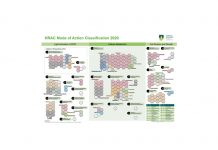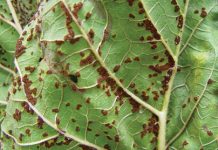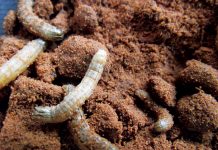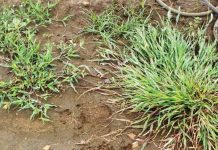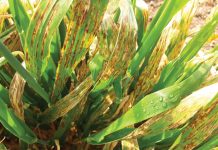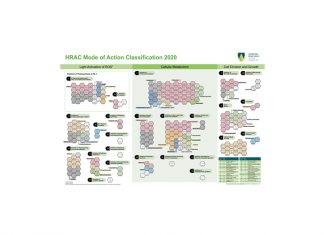
ARC-Grain Crops,
Potchefstroom
 Dr Annemie Erasmus,
Dr Annemie Erasmus, ARC-Grain Crops,
Potchefstroom
Bt maize is genetically modified to express insecticidal proteins and have been planted in South Africa since 1998. In the 2017/2018 season, 1,62 million hectares of Bt maize were planted locally, which is 71% of the total maize area.
In South Africa the main economically important maize stem borers include Busseola fusca (Africa maize stem borer) (Photo 1), Chilo partellus (Chilo borer) and Sesamia calamistis (pink stem borer). An average annual yield loss of 10% is caused by these stem borers. In extremely severe cases, 100% yield losses were recorded in individual farming systems in spite of chemical control measures. All three of these maize stem borers are successfully controlled by Bt maize. Bt transgenic maize can therefore alleviate the stem borer infestation problems to a large extent. However, research indicates that the Africa maize stem borer (B. fusca) is difficult to control, since this species has evolved resistance to the first generation Bt maize planted in South Africa. Resistance development in this stem borer species is a huge concern and continuous monitoring is necessary.
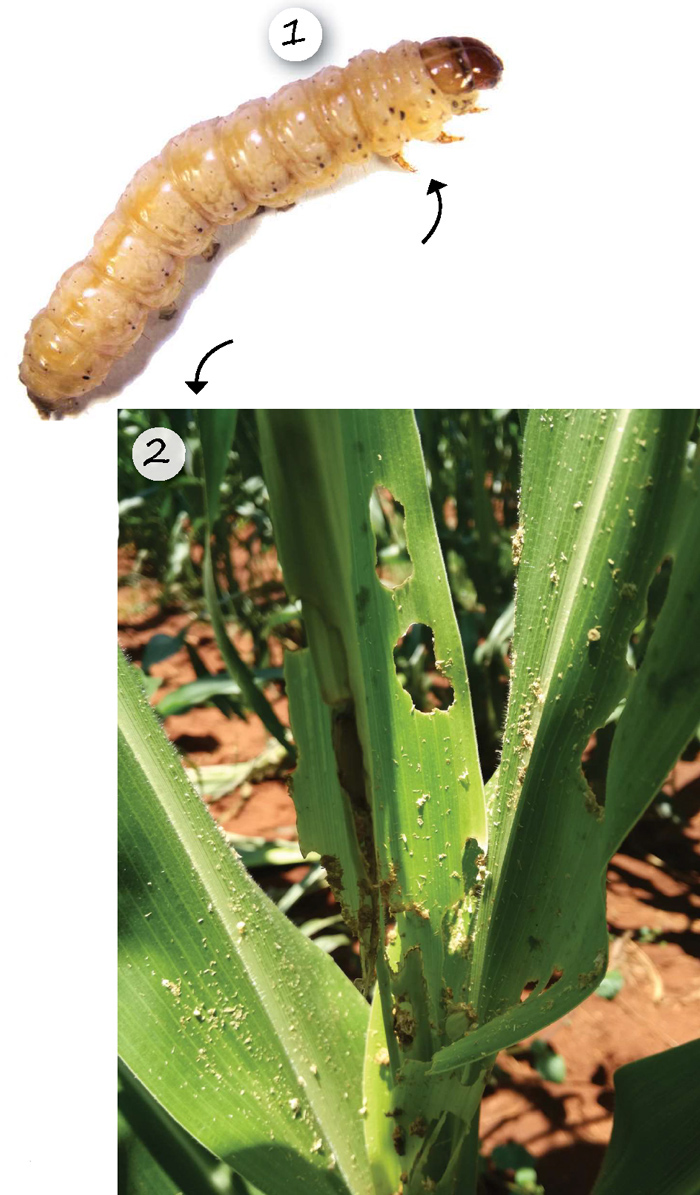
During the 2004/2005 season, Bt hybrids were severely damaged in some irrigation areas. In 2007, the first confirmed case of field resistance was reported in the first generation single-gene Bt event. The next step was gene stacking, to create a Bt event that express more than one gene to control the resistant Africa maize stem borer. The development of the stacked-gene Bt maize was highly successful in controlling the Africa maize stem borer, including those resistant to the single-gene Bt event.
In 2016, Spodoptera frugiperda (fall armyworm) was reported in Africa for the first time. The following year, a positive identification was made in South Africa. This invasive species has a host range of more than 80 plant species and can cause significant yield losses when not managed timeously. Fall armyworm produces several generations per year that are able to reinvade cropping systems and cause extensive damage. The identification of this pest in Southern Africa prompted urgent research to determine whether S. frugiperda was susceptible to Bt maize commercialised in South Africa. Although research is still being conducted, preliminary observations indicate that Bt maize show potential to control fall armyworm under field conditions.
TELA cultivars
Water Efficient Maize for Africa (WEMA) is a project that aims to produce drought-tolerant (DT) and insect-protected maize varieties for small-scale farmers in sub-Saharan Africa. WEMA field trials were approved and launched with hybrids containing the single Bt gene in all WEMA countries except for South Africa. In South Africa, WEMA implements the stacked Bt event, since this Bt event can control B. fusca larvae that developed resistance to the single-gene Bt event. In February 2017, WEMA launched the release of these stacked Bt maize varieties in South Africa under the branded name TELA.
Research was consequently conducted to determine whether TELA will be successful in the control of B. fusca on maize in South Africa. During the 2017/2018 and 2018/2019 growing season, populations of the Africa maize stem borer were sampled from maize fields across the maize production area of South Africa.
Larval development was evaluated under laboratory conditions on TELA cultivars. Three TELA cultivars that contained the stacked Bt gene (WE6206B, WE6208B and WE6210B) and a near isohybrid (WE3128) (non-Bt) were used for the plant-feeding bioassays. This study indicated that Africa maize stem borer larvae were not able to survive on any of the TELA cultivars after 14 days, while on the non-Bt isohybrid, larval survival ranged from 30% to 80% (Graph 1a – c). During the 2019/2020 season, stem borer larvae were screened on the single-gene Bt event and the near isohybrid to compare larval survival to that on the stacked Bt event (Graph 1a). The latter research confirmed that the Africa maize stem borer is still highly resistant to the single-gene Bt event, since no significant differences in larval survival between the non-Bt isohybrid and the single-gene Bt event treatment existed.
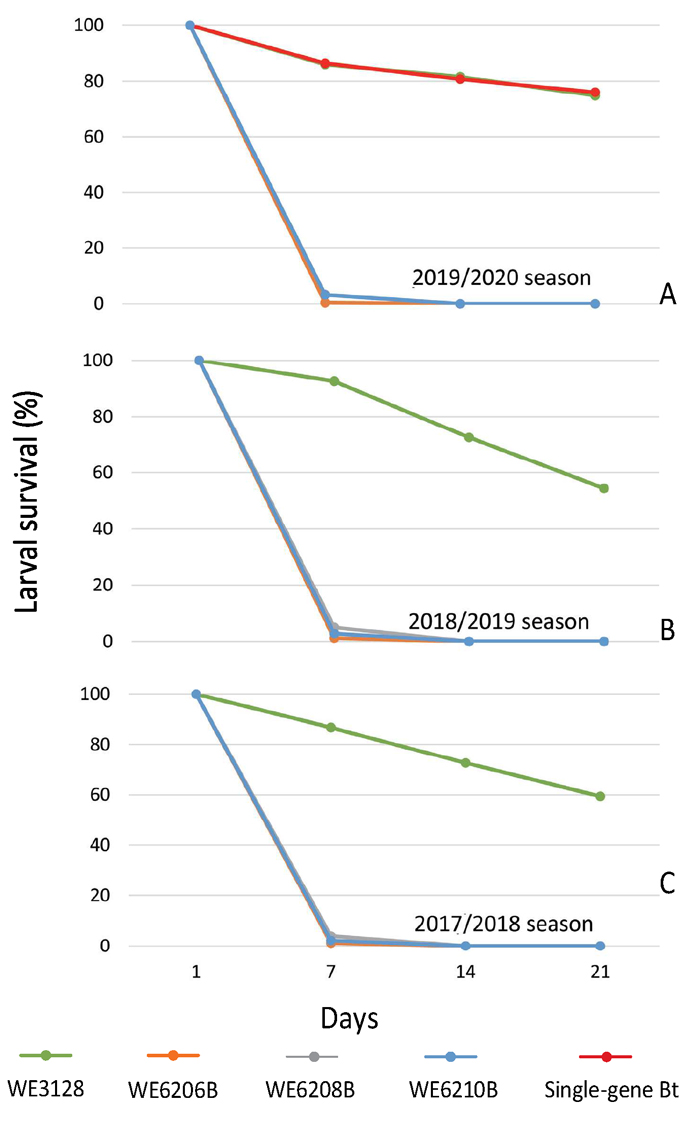
Our research indicated that the TELA cultivars that contain the stacked Bt event show potential to successfully control the Africa maize stem borer.
It is still important, however, to implement the high-dose/refuge strategy to ensure delayed resistance development to prolong the benefits of this technology. The high-dose/refuge strategy is based on a combination of Bt maize producing high doses of toxin within the presence of a nearby non-Bt maize refuge. The purpose of the high-dose Bt maize is to kill off as many stem borer larvae as possible, while that of the refuge is to produce stem borer individuals that survive on the non-Bt maize. The ultimate goal of this strategy is to ensure that the rare, resistant stem borer (RR) that does survive on the Bt maize is not able to produce completely resistant offspring by mating with another resistant stem borer. Susceptible stem borers (SS) from the non-Bt refuge are expected to mate with resistant individuals that survive on Bt maize to produce offspring that are expected to have low to moderate levels of resistance that are unable to survive on maize with high Bt expression.
ARC training
TELA insect resistance management (IRM) training for producers and extension officers is essential to ensure the sustainable use of this Bt technology. The ARC-Grain Crops have had three successful training sessions over the past three years. The training focussed on the international IRM concept used to delay development of resistance to Bt maize. During this training, the importance of scouting and monitoring maize fields (Photo 3), identification of main maize insect pests, Bt technology concepts and IRM are highlighted.

References
- Kotey, DA, Obi, A, Assefa, Y, Erasmus, A & Van den Berg, J. 2017. Monitoring resistance to Bt maize in field populations of Busseola fusca (Fuller) (Lepidoptera: Noctuidae) from smallholder farms in the Eastern Cape Province of South Africa. African Entomology, 25(1), 200 – 209.
- Strydom, E, Erasmus, A, Du Plessis, H & Van den Berg, J. 2019. Resistance status of Busseola fusca populations to single- and stacked-gene Bt maize in South Africa. Journal of Economic Entomology, 112(1), 305 – 315.

- Van Rensburg, JBJ. 2001. Larval mortality and injury patterns of the African stalk borer, Busseola fusca (Fuller) on various plant parts of Bt-transgenic maize. South African Journal of Plant and Soil, 18, 62 – 68.
- Van Rensburg, JBJ. 2007. First report of field resistance by the African stem borer, Busseola fusca (Fuller) to Bt-transgenic maize. South African Journal of Plant and Soil, 24, 147 – 151.
- WEMA – Water Efficient Maize for Africa. 2011. Progress Report. March 2008 – March 2011. pp. 1 – 8.



